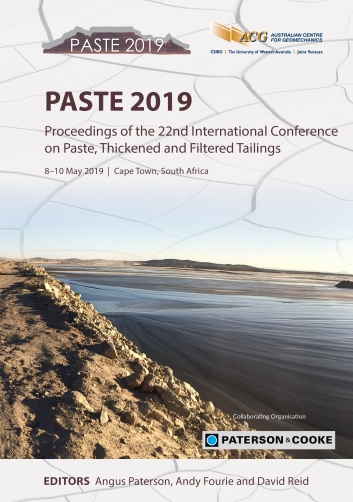Underground paste fill reticulation management of system flow-loss

|
Authors: Griffiths, M |
DOI https://doi.org/10.36487/ACG_rep/1910_41_Griffiths
Cite As:
Griffiths, M 2019, 'Underground paste fill reticulation management of system flow-loss', in AJC Paterson, AB Fourie & D Reid (eds), Paste 2019: Proceedings of the 22nd International Conference on Paste, Thickened and Filtered Tailings, Australian Centre for Geomechanics, Perth, pp. 541-550, https://doi.org/10.36487/ACG_rep/1910_41_Griffiths
Abstract:
An underground paste fill system will inevitably experience a system flow-loss event during its operational life. In a flow-loss event, the underground reticulation design, flow-control hardware, instrumentation specification and system recovery methods can greatly impact the time taken to safely and effectively achieve a full system clearance and recommence backfilling activities. In addition, the learnings and methods discussed in this paper minimise the opportunity cost of using valuable underground work crew resources to rectify the blocked pipe work and the associated paste plant downtime. This deficit of paste filling will further impact the mining production schedule by increasing mining activity interaction and disrupting the extraction sequence. Direct costs of a blockage may include piping replacement and work crew labour as well as an increased risk of injury and equipment damage during a time-critical activity. The management of a flow-loss event must consider each of the following three flow-loss conditions experienced: A case study (Scenario 1) is presented to demonstrate the management of a flow-loss event, which includes system blockage and stalling due to insufficient available head pressure being overcome by system segmentation. Segmentation highlights the advantages of the ability to carry out safe and effective system isolation from underground in a time-critical situation. Reticulation failure response is also discussed in this paper, with an explanation of the recovery method and the requirement of an adaptive approach as the flow-loss condition can transition from one type to another during the recovery effort.
Keywords: paste fill, reticulation blockage, recovery, flow-loss event, dump diverter, surface borehole
© Copyright 2025, Australian Centre for Geomechanics (ACG), The University of Western Australia. All rights reserved.
View copyright/legal information
Please direct any queries or error reports to repository-acg@uwa.edu.au
View copyright/legal information
Please direct any queries or error reports to repository-acg@uwa.edu.au


